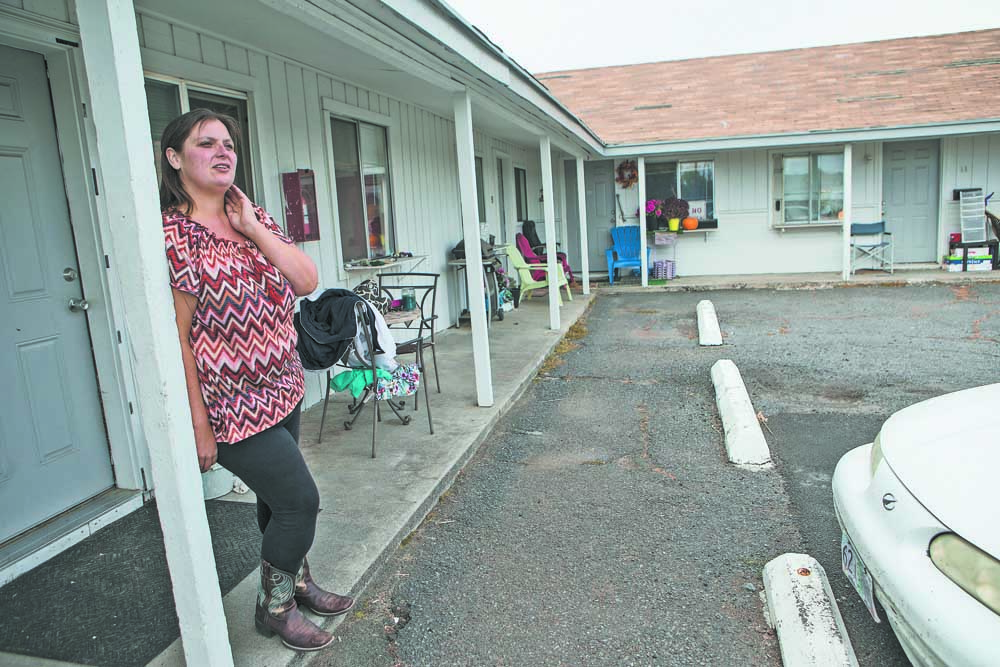Redmond apartments will displace low-income housing
Published 12:00 am Wednesday, October 9, 2019

- Alycia Friend stands in front of her apartment in Redmond on Oct. 2. The apartment building she lives in will be torn down in the next couple years to make room for more expensive apartments.(Ryan Brennecke/Bulletin photo)
REDMOND — Candice Bearce, 39, moved into the Redmond apartment complex at the intersection of NW Kingwood Avenue and NW Sixth Street this spring. Bearce, a full-time student at Central Oregon Community College, said her apartment was one of the few places in Central Oregon that she could afford to live — the rent for her studio is $695 per month — because of high medical costs from living with a chronic illness.
But within a year or two, Bearce’s apartment and the 11 other units at Kingwood and Sixth will be demolished for newer, more expensive units. She and other residents of the complex said they were frustrated and frightened that their low-income apartments will disappear, leaving them with few other options.
Trending
“I won’t be able to live here if they increase the rent,” Bearce said. “If you’re not making six figures, then Central Oregon is pushing you out.”
While many in Central Oregon have asked for more apartments to be built in the midst of a housing crisis, building new units can mean removing low-income housing and displacing the city’s most vulnerable residents.
Local developer Bruce Dunlap’s plan for the Kingwood and Sixth property is to build a 26-unit, three-story apartment complex named Kingwood Lofts. Units will range in size from 394-square-foot studio spaces to 1,435-square-foot two-bedroom units, according to city of Redmond documents.
Construction on the Lofts’ first 14 units will break ground in a couple months on a vacant patch of grass behind the existing apartments, Dunlap said Monday. In either late 2020 or 2021, the current apartment building — a former motel built in the 1940’s — will be torn down and replaced with 12 new units.
Dunlap said the apartments will be market rate, so he won’t know their cost until they open. But if the apartments were available today, the price would range from $800 per month for studios to $1,400 per month for two bedrooms, he said.
Most of the existing units’ rent ranges between $600 and $800 per month, according to residents. Most units are studios, but a couple have been converted into small two-bedroom apartments.
Trending
Alycia Friend, a nanny for children with special needs, said she pays $800 per month to live in one of the two-bedroom units with her husband, Anthony, a security guard at Walmart. Their 12-year-old daughter, Anna Schalock, lives with them half the time, when she’s not with her grandparents, Friend said.
Friend said she’s lived in the apartments for six years, at one point working as the complex’s assistant manager for three years. The kitchen in her unit has a scratched-up linoleum kitchen floor, exposing the plywood beneath, a broken bath faucet and a drooping celling that she’s worried might cave in a heavy snowstorm. However, Friend said the apartments’ reputation and look had dramatically improved in the past few years — she said people used to call them “Felony Flats.”
Friend said “something needs to be done” about building more housing in Central Oregon, but she wasn’t sure that demolishing her complex for more expensive units was the best solution.
“Do we need more low-income housing? Yes,” she said. “Is tearing this thing down the answer? I don’t know.”
Stay-at-home mom Cassandra Herrera, 37, has lived in her apartment for a year with her 11-year-old daughter, who is blind and nonverbal. Herrera’s only sources of income are assistance from the federal government to help her daughter, as well as some funding from local nonprofit Housing Works.
Herrera said she could barely afford her current $650-per-month rent and said she was scared about finding an equally affordable home in Central Oregon.
“Are you just tearing it down, (then) I can’t afford (the new units), so I’m on my own?” she said. “There’s nothing around here that’s affordable.”
Dunlap, the developer, said he didn’t have a plan in place for the soon-to-be-displaced tenants. He said he would offer the new units to the tenants, but agreed some probably wouldn’t be able to afford them.
Still, he said those who can’t afford his new apartments could find housing at the same price elsewhere in the region, and said he was “improving the neighborhood” by building Kingwood Flats.
Real estate websites don’t show any available apartments in Redmond — as well as Bend, Prineville and Madras — below $800 per month as of Tuesday afternoon.
Molly Heiss, the director of housing stabilization at Redmond nonprofit organization NeighborImpact, said her staff is planning to visit the Kingwood and Sixth apartments to help residents in any way they can. Although NeighborImpact doesn’t have money to immediately help the tenants and the group doesn’t own any rental housing, Heiss said they can assist them in signing up for Housing Choice Vouchers — formerly known as Section 8 — and other rental applications or try to find more funding sources within the next year.
“The resources never meet the demand in our area,” Heiss said. “But what we can do, especially if the displacement isn’t going to happen until next year, is keep an eye out for any funding opportunities that could be relevant for those folks.”
Redmond city Councilor Jon Bullock, who expressed concern about Redmond’s lack of affordable housing at a recent City Council meeting, said the city “clearly has a housing shortage” and needed to increase both affordable and market-rate housing. He said he was torn between Redmond needing additional apartments, but also its need to protect its most vulnerable citizens.
“It’s never an easy process to decide, in that situation, do we increase the volume of housing, and in doing so, what is the impact?” Bullock said.
Bullock said he wants to see the City Council discuss increasing Redmond’s affordable housing stock, as well as study those who are displaced after the Kingwood and Sixth apartments are torn down, to find out the best way to help them find housing. He also brought up that the city will soon have 485 incoming units of housing, 50% of which will be affordable, expected to be built on 40 acres on the east side of Redmond.
But for now, current tenants in the Kingwood and Sixth apartments are scared. Gari Jones said she moved into the apartments in September — not because of the low cost, but because of the lack of available apartments in Redmond. She said she was concerned for her new neighbors.
“I’m torn between needing more rentals here, and boy, (other residents) are going to be screwed,” Jones, 56, said.
— Reporter: 541-617-7854, jhogan@bendbulletin.com








